| Operation Crossroads and Radio Bikini by: Larry Pinkston |
|
|
|
 Collins Radio TCS-X Transmitter/Receiver system from public advertising in the WW2 time frame |
| Collins Radio TCS-9 Transmitter returned to the company for display from Operation Crossroads, as shown in the February 1947 issue of the Collins Column magazine. | |
 Link to the issue ...on page 21. |
|
|
This is a view of the Navy Bikini Atoll Officers Club, assumed from behind. It is also assumed that the tent containing the TCS-9 would have been pitched in this general location, along with the Seabee’s generator power supply. |
|
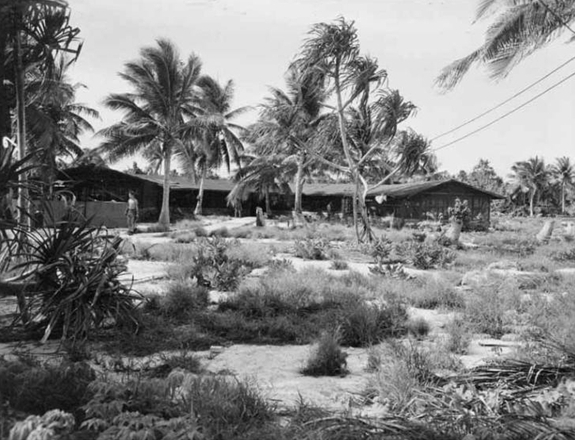 Photo Credit: U.S. Navy |
|
Identification of the Bikini atoll and locations of the Target Area and U.S. Naval Station (directly adjacent) at the Bikini settlement area. |
|
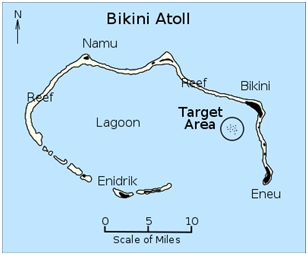 The Bikini atoll and locations of the Target Area and U.S. Naval Station (directly adjacent) at the Bikini settlement area. |
 Layout of ships in target area for Able test. The actual Ground Zero of Able test was off by 2,130 feet. |
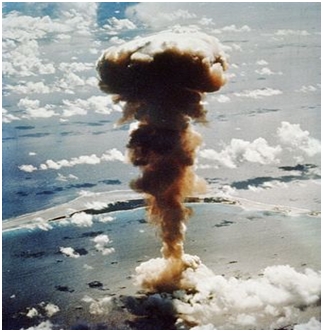 Aerial view of the "Able" detonation of Operation Crossroads with Bikini Atoll settlement area shown in background. |
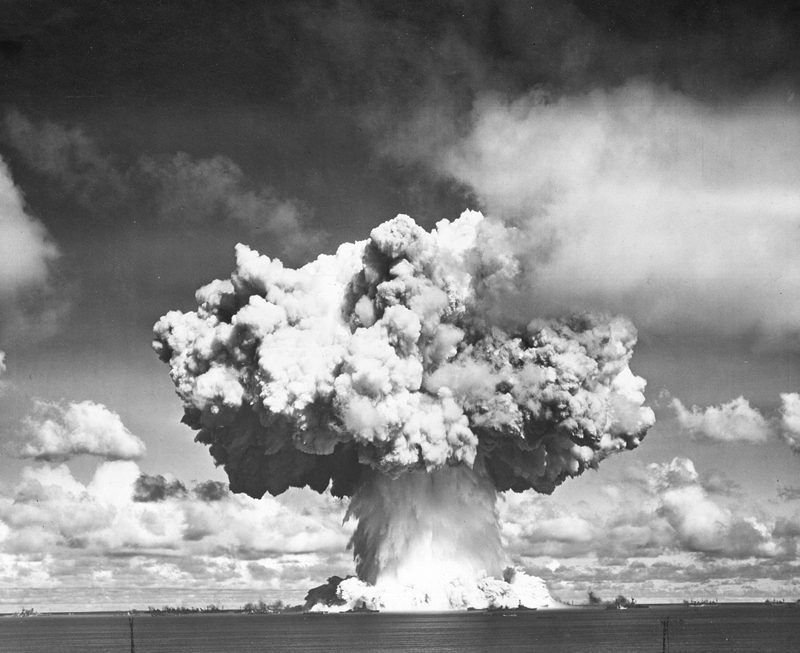 Surface view of the "Baker" detonation of Operation Crossroads. The Wilson cloud has evaporated. |
|
|  Image credit: Army Field Manual 8-9. |
| Conserving the Radio | |
|
High resolution blown-up image of the TCS-9 Bikini Radio Transmitter as returned to Collins Radio in 1947. |
|
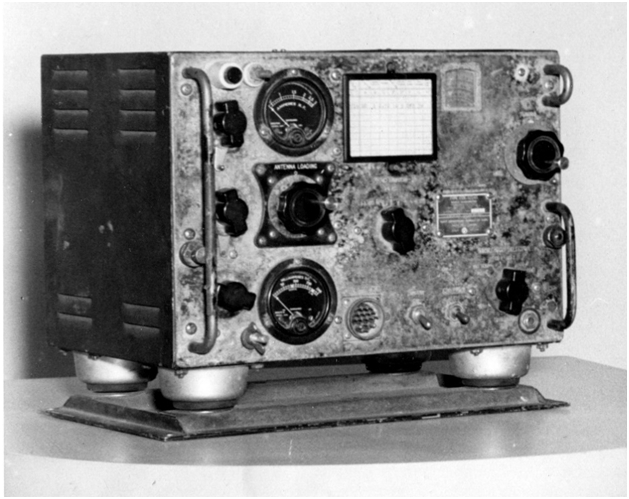 Click to Embiggen |
|
|
Photograph of the TCS-9 Bikini Radio Transmitter as it appeared following 74 years of storage after return to Collins Radio in 1947 |
|
 |
|
|
Photograph of the TCS-9 Bikini Radio Transmitter following a light cleaning and probing for identifying markings, tuning scales, and evidence of participation in 1946 nuclear tests at Bikini Atoll. |
|
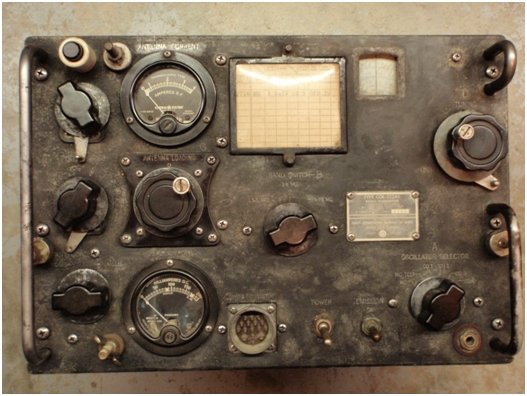 |
|
|
Photograph of the TCS-9 Bikini Radio Transmitter showing debris that fell from the unit as it was removed from the present case enclosure. |
|
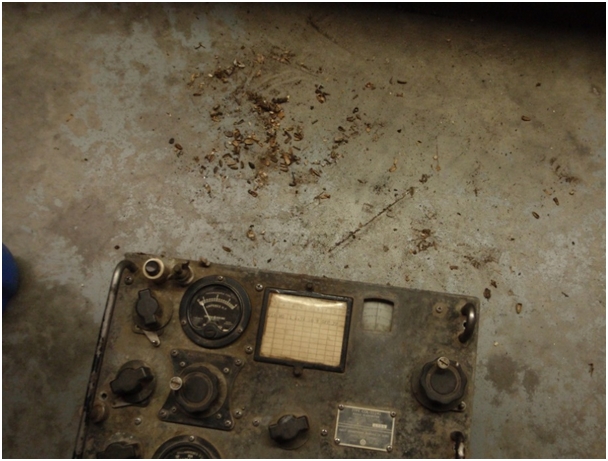 |
| Bikini Radio Observations beginning 5 March, 2021 | |
|
1. The unit is identified as a Navy type TCS-9 HF Transmitter, COL-52245, with serial number 1704. 2. The unit is identified as having served at the Operation Crossroads nuclear test site in 1946 and received back at Collins Radio in 1947. 3. An article was observed in the Collins Column magazine dated February 1947 identifying the item and indicating it to be functional at the time. 4. A blown-up image of the front panel of the unit indicates: a. Most of the panel, tuning scales and knob skirts are contaminated, obscured, or oxidized in such a way that the “A-B-C” tuning feature of the TCS architecture could not be performed in any normal manner. b. The tuning chart and its framework appear to be fresh and legible, standing out in the picture, showing a single tuning frequency believed to be 2716 KHz. c. The tuning knobs "A" and "B" are shown in positions not possible on a stock TCS production unit. Knob "A" appears to have no skirt or it is heavily obscured by residue or corrosion. d. The facing surface of all Bakelite tuning knobs appear to have a smooth and undamaged appearance. e. The tuning meters, top and bottom appear to be clean and readable. f. The tuning frequency dial (for the MO) appears to be somewhat contaminated and possibly difficult to read. g. A thumb nut is missing from the antenna terminal. h. The unit is mounted on the traditional four robust shock mounts 5. This same unit was retrieved from a collector in 2014, and identified by the serial number 1704. 6. Review of the retrieved unit as of 2021 is noted to have the following features not consistent with the only known picture of the unit from 1947. a. The unit appears to have an additionally dusty appearance that may be consistent with it being in storage for 74 years since the original photo was taken. b. The frame around the tuning chart appears to have become somewhat rusted or contaminated during storage by comparison to the original photo. c. The tuning positions at "A" and "B" both have skirted knobs and now can only be adjusted to the specified positions consistent with a stock TCS-9 production unit. d. The top meter (Antenna Current) is not identical to that shown in the early 1947 photo and appears to have been replaced. e. The lower meter (Plate Current) is found to be identical to the early photo, however, appears to have some vertical haze or streaking on the inside of the glass, not previously appearing there. f. The tuning dial for the MO appears to be less legible than before with dirt and possible insect webbing noted behind the plastic window. g. A wing nut now appears on the antenna terminal but no longer on the ground terminal. h. The unit is no longer mounted on the four shock mounts and the case enclosure appears to have been changed, since the Collins Mfg. identification plate on the top indicates a TCS-8 version, not TCS-9. It also indicates serial No. 2864 and is stamped as accepted by the Navy in 1944 7. Since this unit was identified as being on Bikini Atoll during both the Able and Baker fission bomb tests, residual fallout contamination was considered a possibility. The unit was then surveyed using a Victoreen CD-700 Survey/Inspection Geiger counter at its most sensitive setting. The result was no perceptible radiation count over that of the background. 8. It was then desirable to remove the unit from the present enclosure to inspect it internally. This was met with significant resistance as the unit appeared to either be rusted, or corroded, into place. The two side locks were carefully assured to be open. It was noted that two rivets are located at the bottom, possibly holding composite guides in place. Drilling out the rivets, allowed the unit to move forward about ½ inch, such that a flat bar could easily be inserted. This action allowed the grip to be broken, and removal followed. 9. As the unit was slid from its case, a considerable amount of debris fell to the floor. This was photographed (Figure 13). Internally, a considerable amount of insect webbing was noted and brushed out. A musty smell was noted. 10. The following internal observations were noted and photographs (Figures 12, 13, 14, & 15) taken. a. Most ferrous metal surfaces showed rusting, many were significant. b. Copper conductors, solder joints, relay contacts, and other unprotected surfaces all showed significant signs of corrosion. c. A fungus like growth was noted around the antenna ammeter and other locations, which was left intact. Dust was lightly brushed away and the unit gently vacuumed in a few locations. d. The base clamps on the four 1625 amplifier tubes were loose and some tubes not seated firmly. There were no hold-down clamps on the three 12A6 tubes, which would normally be specified for this model of radio transmitter. e. No crystals were noted in the four oscillator sockets and never appeared to have been present since the original thumbnut locking wires were observed to be wound in place on the hold-down clamps. Frequency control would only have been achieved through use of the Master Oscillator (MO) or VFO. 11. Since radioactive contamination could have been harbored within the unit in 1947, the Geiger counter was again used and passed around inside cavity areas. A very slight popping was noted only in the region of the 1625 tubes which is assumed due to thoriated tungsten applied to the cathodes, which is normal, otherwise nothing but background count was observed. 12. Attention was then focused onto the front panel of the unit. a. The unit matched the original photo in many ways, but had a generally deteriorated appearance, particularly on the left side. Areas can be seen on the right side that generally underscore similarity, but also show the signs of considerable aging and dust/residue accumulation. b. It was decided to gently clean the unit with a cotton rag, containing a mild detergent solution. In this way evidence of thermal effects from the Able event, if present, could be discerned. Also, dial markings and legends that probably would have been visible to the 1940’s radio operator at the Bikini Atoll could be found. Some bristle brushing was also performed, as the cotton rag could not reach all areas. This brushing technique only led to some recognition of tuning indicators and legends beyond that discernable in the 1947 photo. This action may have been too thorough, however, to preserve all of the patina that may be discernable between the original 1947 and later photos of the unit. c. The technique used to find burnt or carbonized paint was by rubbing some cleaned areas with slightly abrasive white paper strips and also close observation with a magnifying glass. The paint appeared to be intact and still resilient in all areas tested, showing no signs of burning. The dial markings, however, became somewhat more visible. The left side of the radio again appeared to show more sign of deterioration than the right side. d. A test was then performed (Figure 16) on surplus, similar period, knobs for the effect of thermal exposure. Some data collected indicated that at 3 miles from the Able (23 KT) event, approximately 2-3 calories per CM2 of heat would be absorbed by an exposed black Bakelite surface. Roughly, this could elevate temperature to about 800 degrees F in a couple of seconds, since Bakelite has poor thermal conductivity. Using both a heat gun and a propane torch, it was shown that blistering of the Bakelite surface occurred in several seconds. A high temperature probe seemed to verify the numbers; however, precise thermal calibration could not be achieved. This test was only performed as a qualitative reference. The smooth preserved surface of the knobs on the TCS unit confirmed that it was unlikely that exposure to significant nuclear thermal effects occurred. 13. A conclusion was drawn that the surface condition (patina) of this TCS-9 transmitter was due to moist or contaminating storage, including both the Kwajalein Navy depot and the method of storage in the 74 years since return of the unit to Cedar Rapids, IA. It was also concluded that several changes or possibly modifications were made following the Collins Column display, evidenced by the dissimilar antenna current meter, repositioning of the A and B tuning knobs, lack of original shock mounts, and outer enclosure with conflicting identification credentials. It was also assumed that the positioning of the tuning knobs at A and B were changed in the field to allow the knob handles to point to the desired position, since the knob skirts had been obscured. The remainder of the tuning steps could be performed by an experienced radio operator at Bikini Atoll without scale legends being required. The tuning chart also would have been replaced to accommodate the operating frequency of the rebroadcasting station. The unit was credited as "still in operating condition" upon return. It is not known what measures may have been required to support that status or how testing was performed. 14. Photographic results: |
|
 General internal view of transmitter following removal from case. Figure 12. |
|
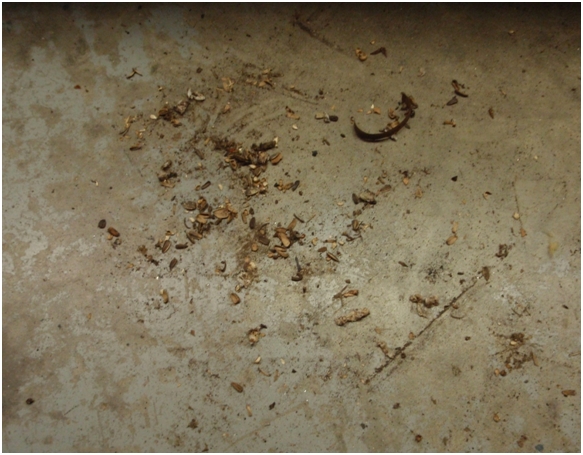 Closeup of debris falling from transmitter case during removal. Figure 13. |
|
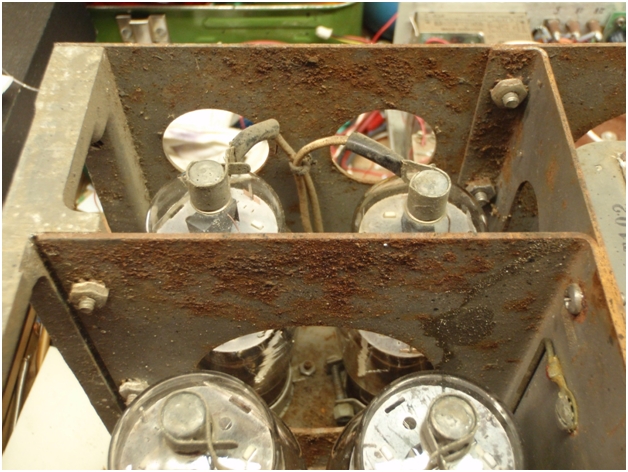 View of rusting conditions. Figure 14. |
|
 Rear view of replaced antenna current meter as found, March 2021. Figure 15. |
|
| Test of period style Bakelite knobs before and after estimated heat application consistent with nuclear thermal exposure (approx. 2.0 Cal/CM2). | |
 Figure 16. |
Formula: Q=mc(Delta T) Q = heat energy (Calories) m = mass c = specific heat capacity Delta T = change in temperature Therefore: Delta T = Q/mc |
| Conclusions drawn from Radio Bikini TCS-9 Analysis | |
|
1. The TCS-9 Radio Transmitter, Serial 1704, manufactured by Collins Radio in the 1940’s time frame was used as a rebroadcast source in the Bikini Atoll nuclear weapons test, Operation Crossroads, by the U.S. Navy, assisted by the Navy Seabees, in 1946. 2. The Transmitter was tuned to 2716 KHz. via the internal variable Master Oscillator (MO). 3. The call sign for the station was referred to as NICO-1. 4. The TCS-9 Transmitter was operated in a tent, pitched on the grounds of the Navy Officers Club referred to as “Up and Atom” for a period of approximately 3 months. 5. The antenna used in this operation is not known, however, the Antenna Condenser switch (F) according to the tuning chart is “Off” and no External Load Coil (H) is required, indicating that this antenna was matched to within the baseline tuning range of the TCS-9 design at 2716 KHz. 6. It is presumed that the transmitter was operated in the AM mode with an audio source correctly matched in impedance and amplitude to the carbon microphone specification used for the TCS-9 design. 7. The transmitting power of this TCS-9 was 25 watts coming from only one 1625 final amplifier tube per TCS-9 specification, indicating a small area of broadcast coverage. 8. The source of this transmitter was the Navy Surplus Stock Pool located at Kwajalein Atoll in the Marshall Islands just prior to the beginning of Operation Crossroads. 9. Upon receiving this unit back from the US Navy, it was identified in the February 1947 edition of Collins Column magazine on page 21 as “stained and seared” but in “perfect working condition”. 10. By the description of “stained and seared” it might be concluded that this radio was in some form of contact with the environments generated by the Atomic (Nuclear) testing of Operation Crossroads. 11. Careful analysis and some testing of the TCS-9 Transmitter as recovered in 2021 does not indicate any significant evidence of nuclear weapon residue or “searing” as might have been expected within the range of exposure. 12. Considerable residue and obscuring of the TCS-9 faceplate, however, was noted in both the present and historical photos of the unit. 13. The condition of this TCS-9 is now suggested to have resulted from deployment and storage in a south sea’s salty environment (Kwajalein surplus stock pool), as well as storage for 74 years in an uncontrolled environment in Iowa. 14. It is likely that this radio transmitter was provided to the Operation Crossroads project as a last-usage asset, performed as expected, not directly exposed to the nuclear environments, and considered safe to return to the Collins Radio company as a legacy asset for display. |
|